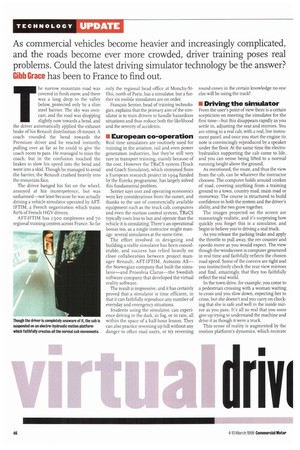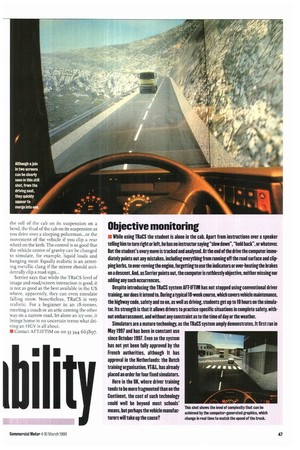As commercial vehicles become heavier and increasingly complicated, and the
Page 48

Page 49

If you've noticed an error in this article please click here to report it so we can fix it.
roads become ever more crowded, driver training poses real problems. Could the latest driving simulator technology be the answer? Gibb Grace has been to France to find out.
The narrow mountain road was covered in fresh snow, and there was a long drop to the valley below, protected only by a slim steel barrier. The sky was overcast, and the road was dropping slightly now towards a bend, and the driver automatically applied the exhaust brake of his Renault distribution i8-tonner. A coach rounded the bend towards the Premium driver and he reacted instantly, pulling over as far as he could to give the coach room to pass. He managed to miss the coach, but in the confusion touched the brakes to slow his speed into the bend and went into a skid. Though he managed to avoid the barrier, the Renault crashed heavily into the mountain face,
The driver banged his fist on the wheel, annoyed at his incompetence, but was unharmed—not least because he was actually driving a vehicle simulator operated by AFTIFTIM, a French organisation which trains 8o% of French 1-IGV drivers.
A FT-I FTI M has 1,500 employees and 7o regional training centres across France. So far only the regional head office at Monchy-StEloi, north of Paris, has a simulator, but a further six mobile simulators are on order.
Francois Serrier, head of training technologies, explains that the primary aim of the simulator is to train drivers to handle hazardous situations and thus reduce both the likelihood and the severity of accidents.
• European co-operation
Real time simulators are routinely used for training in the aviation, rail and even power generation industries, but they're still very rare in transport training, mainly because of the cost. However the TRaCS system (Truck and Coach Simulator), which stemmed from a European research project in 1994 funded by the Eureka programme, has largely solved this fundamental problem.
Serrier says cost and operating economics were key considerations from the outset, and thanks to the use of commercially available equipment such as the truck cab, computers and even the motion control system, TRaCS typically costs less to buy and operate than the vehide it is simulating. There's an operational bonus too, as a single instructor might manage several simulators at the same time.
The effort involved in designing and building a viable simulator has been considerable, and success has relied heavily On close collaboration between project manager Renault, AFT-IFTIM, Autosim AS— the Norwegian company that built the simulator—and Pros olvia Clams—the Swedish software company that developed the virtual reality software.
The result is impressive, and it has certainly proved that a simulator is time efficient, in that it can faithfully reproduce any number of everyday and emergency situations.
Students using the simulator, can experience driving in the dark, in fog, or in rain, all within the space of a half-hour lesson. They can also practice reversing up hill without any danger to other road users, or try reversing round cones in the certain knowledge no one else will be using the track!
• Driving the simulator
From the user's point of view there is a certain scepticism on meeting the simulator for the first time—but this disappears rapidly as you settle in, adjusting the seat and mirrors. You are sitting in a real cab, with a real, live instrument panel, and once you start the engine its note is convincingly reproduced by a speaker under the floor. At the same time the electrohydraulics supporting the cab come to life, and you can sense being lifted to a normal running height above the ground.
As mentioned, the route, and thus the view from the cab, can be whatever the instructor chooses. The computer holds around iookrn of road, covering anything from a training ground to a town, country road, main road or motorway. The course is structured to build confidence in both the system and the driver's ability, and the two grow together.
The images projected on the screen are reassuringly realistic, and it's surprising how quickly you forget this is a simulator, and begin to believe you're driving a real truck.
As you release the parking brake and apply the throttle to pull away, the rev counter and speedo move as you would expect. The view though the windscreen is computer generated in real time and faithfully reflects the chosen road speed. Some of the corners are tight and you instinctively check the rear view mirrors and find, amazingly, that they too faithfully reflect the real world.
In the town drive, for example, you come to a pedestrian crossing with a woman waiting to cross and you slow down, expecting her to cross, but she doesn't and you carry on checking that she is safe and well in the inside mirror as you pass. It's all so real that you soon give up trying to understand the machine and drive it as though it were a truck.
This sense of reality is augmented by the motion platform's dynamics, which recreate the roll of the cab on its suspension on a bend, the thud of the cab on its suspension as you drive over a sleeping policeman...or the movement of the vehicle if you clip a rear wheel on the kerb. The control is so good that the vehicle centre of gravity can be changed to simulate, for example, liquid loads and hanging meat. Equally realistic is an arresting metallic clang if the mirror should accidentally clip a road sign...
Serrier says that while the TRaCS level of image and road/screen interaction is good, it is not as good as the best available in the US where, apparently, they can even simulate falling snow. Nonetheless, TRaCS is very realistic. For a beginner in an 18-tonner, meeting a coach or an attic coming the other way on a narrow road, let alone an icy one, it brings home in no uncertain terms what driving an FICV is all about.
III Contact AFT-IFTI NI on oo 33 344 663897.








































































































